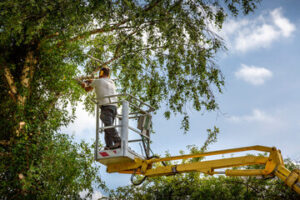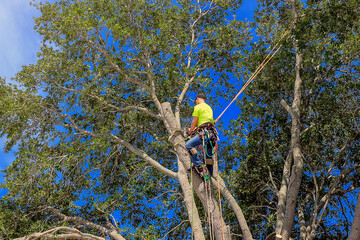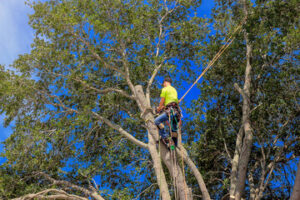Trees are important in our landscape for beauty, shade/energy reduction, and windbreak purposes. They also protect property, people, and vehicles from damage from falling limbs.
Georgetown Tree Services is critical to its ability to withstand storms. Preventive measures include erecting barriers or “No Dig” zones around the base of young trees, pruning to create strong crotches, and deep watering to promote surface roots.
Tree pruning is the practice of selectively removing plant parts (buds, branches, and spent flowers) to manipulate plants for horticultural and landscape purposes. It also helps maintain good air circulation within a plant’s framework.

Performing regular pruning on trees keeps them healthy and looking their best. It is an important part of tree care and should be done by a certified arborist to ensure proper technique. Pruning is a skill that takes time to learn and has a direct impact on the way your plants grow. Depending on where and how you cut, it can change how your shrubs and trees look for years to come.
Removing dead or damaged branches prevents insects and disease from spreading from one branch to other. It also allows grass and other plants around the base of the tree to thrive. It can also help keep people and vehicles safe by preventing large limbs from falling onto sidewalks or roads.
Pruning a tree can be done at any time of the year, but it is best to trim deciduous and evergreen trees in the fall or winter during their dormant season. This is because the cuts made to the stems during this period heal more quickly and are less prone to infection by insects and fungi.
Some shade and flowering trees bleed or excrete large amounts of sap from their pruning wounds, especially maples, birch, oaks, elms, dogwoods, flowering plums, and willows. This bleeding can be unsightly and may attract stinging insect pests. You can minimize the amount of bleeding these trees do by pruning them after they have set their buds for the current season or just prior to the onset of their new growth in spring.
Certain shade and flowering trees, particularly willows, maples, birch, oaks, elms, dogwoods, and flowering plums, bleed or expel copious amounts of sap from their pruning wounds. This bleeding may draw stinging insect pests and be unsightly. By pruning these trees after they have set their buds for the current season or just before the onset of their new growth in the spring, you can reduce the amount of bleeding that these trees cause.
When pruned incorrectly, a tree can suffer from several consequences including low-vigor limbs, weak codominant stems, bark inclusions, and dead limbs that fall. It can also become overgrown and obstruct the view of a home or reduce its value. Ultimately, improper pruning can damage your property and even cause injury to those who are nearby. It is critical to have your trees professionally pruned to prevent any costly damage or injury.
Newly planted trees need ample water to establish a firm root system. However, too much water can drown the roots and lead to tree death. Developing an effective watering plan accounts for both the season and the amount of rainfall that your area receives.
When the weather turns hot, the need to regularly water your trees increases. Drought stress can lead to the growth of unhealthy and weakened branches and leaves. It can also increase the susceptibility of your trees to diseases and insects. The best way to protect your trees is by regularly watering them during the summer and drought periods.
The type and amount of water your trees need will vary by species, location, and soil conditions. However, a general rule of thumb is to water them until they are soaked to the point that no runoff occurs. This means you should water the soil up to about a foot past the edge of the canopy or drip line. This is important because the root system of most established trees extends out well beyond this area.
During the spring and summer, new or young trees need to be watered every other day. During this time, it is also essential to water your trees on days when they don’t rain. Watering after a rain storm can actually cause more damage to your plants because it can encourage root rot and fungi.
It is also a good idea to water your trees during the evenings or mornings, as this will minimize the amount of water lost due to evaporation. Watering in the middle of the day can also stress your trees by preventing them from absorbing the moisture they need.
When watering your plants, use a soaker hose or similar porous hose that can slowly ooze water into the soil. This is better than using a sprinkler, which can be more damaging to the plant as it tends to splash onto its leaves instead of soaking into the soil. If you need to use a sprinkler, be sure to turn it off when the water begins dripping off the hose so that your plants do not become overwatered.
Fertilizing is the process of adding nutrients to soil to improve its quality and encourage plant growth. Generally, natural or manufactured material is used for this purpose. It is distinct from soil amendments, such as liming materials or other non-nutrient soil treatments.
Most fertilizers are composed of nitrogen, phosphorous, and potassium (N-P-K). They also typically contain trace elements such as calcium, magnesium, iron, manganese, copper, zinc, molybdenum, and sulfur, as well as other micronutrients that help the plants absorb other minerals. These are known as secondary nutrients.
A few of the more common sources of N-P-K fertilizers are animal dung, manure, rock phosphate, and fish emulsion. These organic products are considered to be more environmentally friendly than the synthetic varieties. They usually come in the form of granules or liquids and are applied directly to the soil or to the plant.
Liquid fertilizers are diluted in water and then poured over the roots of the plant or sprayed on the leaves. They are a quick and easy way to feed your plants. However, you must be careful not to overfeed your plants as this can lead to a buildup of salts and a variety of other problems including fertilizer burn, root rot, and disease.
Most liquid fertilizers are labeled with a number indicating the proportion of each of the three primary nutrients: a complete fertilizer is one that has the same ratio of all three, whereas a balanced fertilizer contains equal amounts of each nutrient. There are also specialty fertilizers, such as those for African Violets or Citrus plants, that contain optimized proportions of nutrients for those particular types of plants.
It is important to note that fertilizing can not fix a stressed plant. If a plant is already struggling with lighting issues, watering or humidity problems, it will not be able to absorb the additional nutrients sent its way and this can actually cause damage to the plant. Likewise, it is best to only fertilize when the plant is growing normally and in the right conditions. If you notice a deficiency in the plant, such as chlorosis (yellow leaves with green veins), this can be corrected with chelated iron, for example.
Pests are unwanted organisms that interfere with desirable plants in fields and orchards, landscapes, and forests; damage buildings and other structures; or harm human health. A pest may be a plant, vertebrate (bird, rodent or other mammal), invertebrate (insect, tick, mite, or snail), nematode, or pathogen (bacteria or fungus). Monitoring pests helps you determine whether a pest population can be tolerated or if control is needed, and which management strategy to use. Pest control includes the regular treatment of ants, earwigs, grubs, and other pests that can cause problems with your trees. It also means reducing rodent populations to prevent disease like Plague, Hantavirus Pulmonary Syndrome, Lassa Fever and Salmonellosis.



 When looking for a tree service, it is important to find a certified or accredited professional. Although accreditation is not as important as it used to be, it can be a good indicator of a reputable service. You can check for this certification by looking for online reviews and asking for references. Accredited tree services have been through professional development programs and are on the leading edge of best practices in tree care. They are more likely to have extensive experience and expertise than novice arborists, making them a better choice for a tree care project.
When looking for a tree service, it is important to find a certified or accredited professional. Although accreditation is not as important as it used to be, it can be a good indicator of a reputable service. You can check for this certification by looking for online reviews and asking for references. Accredited tree services have been through professional development programs and are on the leading edge of best practices in tree care. They are more likely to have extensive experience and expertise than novice arborists, making them a better choice for a tree care project.